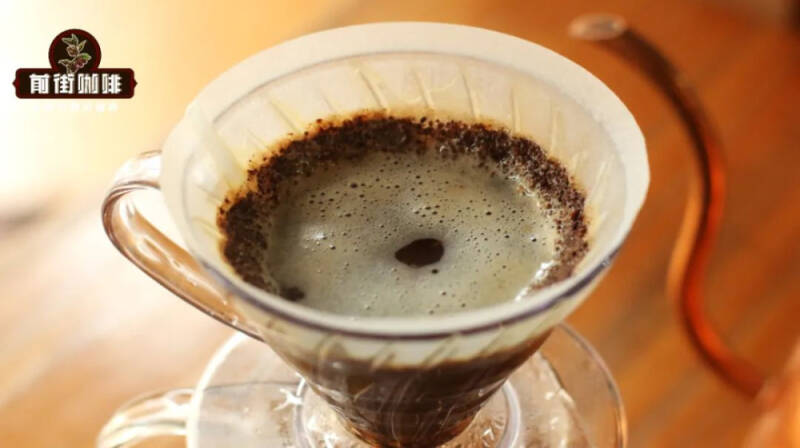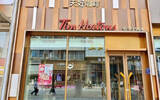The right way and technique for making coffee: What if the coffee is too bad?

For any coffee lover, no matter what their favorite flavor is, the goal of learning to make coffee is the same: it tastes good. We carefully select equipment and beans, pay attention to parameters, the pursuit of techniques. Which is not to make the coffee taste better, is it?
However, compared with professional baristas, we have less experience in brewing coffee at home, and our equipment is not as complete and sophisticated as that in the store, so we occasionally encounter some difficult and complicated problems in brewing. I don't know which detail went wrong and how to solve it.
Next, Qianjie will combine different practical cases to answer common extraction questions in family cooking.
1. The water in the tail section is serious, and the coffee liquid has not been dripped for a long time.
This is a problem encountered by many novice friends. The so-called "stagnant water" actually means that too much fine powder blocks up the gap in the filter paper, resulting in the problem of slow launching, and the filtration time is usually more than two and a half minutes. Too much fine powder, the bottom of the powder pit is generally wet, and even starching, coffee will also be bitter, and even with a little less pleasing woody flavor. This kind of fine powder is mainly affected by two aspects, one is the bean grinder, the other is the degree of grinding.

No matter which kind of grinder is used, roasted coffee beans will produce more or less ultra-fine powder during the bursting process before grinding, and they are often much smaller than the expected thickness of grinding. Compared with the household hand grinder, the electric bean grinder has a larger and finer cutter head, faster grinding frequency and less heat generation, so the grinding quality is more uniform and the proportion of ultra-fine powder is less than that of manual grinding.
In the face of always blocking the water, Qianjie suggests that under the premise of ensuring the uniform grinding of the bean grinder, we should first try to thicken the grinding degree to see if the flow rate and taste are improved. If the flow rate becomes faster, but the taste is a little light, you can try to increase the water temperature by 1-2 degrees or reduce the powder-to-water ratio to coordinate. However, if the thickening is still blocked, and the surface is obviously large particles, then you might as well purchase a special sieve to remove some of the very fine particles smaller than 0.2mm, in order to reduce the bitterness caused by overextraction.
two。 With the same degree of grinding, the flow rate suddenly increases.
Many friends have responded to this situation in the front street: one day, when they changed a bag of coffee beans, they obviously wrote the type of flower and fruit flavor as before, so they did not adjust the grinding degree, but as soon as they were injected with water, they found that the speed of getting into the water was very fast. the usual extraction process of more than two minutes is now finished in less than a minute and a half. From the experience of the former street, if nothing happens, these buddies should buy new beans of anaerobic type.
After sealed fermentation, the internal structure of anaerobic coffee beans will become very soft, and even if it is roasted shallowly, it will have a lower density than the beans treated by traditional methods such as sun exposure and washing. On the other hand, the roasted anaerobic coffee beans will have larger pores, and at the same grinding scale, the flow rate will be much faster than other fruit acid beans, so the probability of insufficient extraction is greater.
Therefore, in order to make the coffee taste fuller, when we grind these anaerobic beans, we should adjust the scale slightly, with segmented water injection to prolong the time of scouring the powder layer, and then improve the release efficiency of soluble substances.
3. Sometimes the coffee tastes good, but sometimes it is full of miscellaneous flavor.
A cup of coffee tastes good, and Qianjie believes that it is inseparable from three key elements: coffee beans, bean grinders and water. If we can be sure that there is no problem with the quality of the coffee beans (for example, we can smell a good aroma when grinding), the bean grinder and the grinding scale are in a reasonable range, and there is no big problem, that is, the powder layer is regular and fluffy, but the coffee always tastes wrong, then there is a good chance that it is the water quality.
In the water we come into contact with, various minerals will exist in trace forms, which, though not easy to detect, can directly affect the softness and hardness of the water. Studies have shown that the right amount of calcium ions in water can better dissolve the acidity of coffee, while water with appropriate amount of magnesium ions can effectively improve the sweetness and aroma release of coffee. But if the magnesium ion is more, the coffee will be bitter, the calcium ion will be more, and the coffee will easily become miscellaneous and astringent.
Therefore, if you want to make the coffee taste good, you can't "make do" with water. As for whether to choose pure water, mountain spring water, mineral water, or filtered water at home, you can refer to the previous "Water article" in Qianjie.
4. Coffee flavor is lack of hierarchy, acidity and water feeling. When distributing water around a circle, some people are accustomed to a small circle of water throughout the whole process, so that the liquid level is always maintained at half the height of the filter cup; others like to drench all the coffee powder in each section of water, sometimes pouring it on the wall of the filter cup, so that it can be extracted evenly.
The former causes the water to wash only part of the coffee particles in the center, while the latter rushes down the previously stacked powder wall, and both habits make the coffee powder silt at the bottom, and the coffee is either insipid and tasteless. or low, rich tone, lack of layering.
In addition, there is another situation, that is, the intensity of water injection at the end is too strong. The water column with too much force will break through the previously stacked wall, and this section of coffee powder will be washed down, forming a form of breaking in two. If you continue to inject water into the broken part, the hot water will flow away from the ribs at the edge of the cup directly through the filter paper, resulting in a "channel effect", that is, the extraction is uneven, while the particles attached to the surface of the filter paper do not participate in the extraction. as a result, the coffee is sour, light and heavy.
It is not difficult to get the coffee out of a good flavor level. Take the three-stage style commonly used in the front street as an example, after the end of steaming, it will first take a steady vertical large flow, maintain a uniform distance from the liquid level 3-4cm to wash the powder layer around, and constantly expand the range clockwise from the center to the periphery, until the weight of the timing scale shows 125g.
As the liquid level rises, there will be less and less coffee powder that can be attached to the filter paper. when the water level falls to half of the water level, it begins to circle around the concentric circle along the radius of the liquid level at 1 and 2, and is injected gently with a small flow with high 2cm.
5. The end of coffee always smells of smoke or coke.
In the cup test, the smell of smoke and coke is generally considered to be a negative taste to deduct points, which usually appears in over-roasted coffee beans, and the entrance feels like a cigarette gun emitted by burning wood. In the home brewing mode, this kind of flavor is more likely to be caused by the failure to find the right parameters when brewing deep-roasted coffee.
We should know that deep-roasted coffee beans are heated for a longer time, and the tissue structure of the beans is already in a very loose state. If you use a hand grinder to grind the beans, you can feel that they are easily crushed into powder. It is conceivable that under the flushing of hot water, it will be easier to release baking flavor substances, which will accidentally turn into a cup of "Cantonese-style herbal tea". Therefore, in order to avoid over-extraction of coffee, we should avoid too high water temperature and too fine grinding when setting brewing parameters.
Qianjie recommends that it is best to reduce the water temperature to 86-88 °C for deep-boiled baked beans, and try to use coarse sugar (70% of the standard sieve 20) for coffee grinding. the circle speed during water injection is slower and the action is as gentle as possible. this can not only avoid the smoky smell of coffee, but also have a good mellow thickness.
-END-
Front Street Cafe
No. 10 Baoqian street, Yandun road, Dongshankou, Yuexiu district, Guangzhou, Guangdong province
Important Notice :
前街咖啡 FrontStreet Coffee has moved to new addredd:
FrontStreet Coffee Address: 315,Donghua East Road,GuangZhou
Tel:020 38364473
- Prev

The first store becomes the "first withdrawal"! Coffee chain brand Tims cannot escape the fate of closing new stores in good weather
▲ Click to pay attention| Among the coffee brands in the various chain chains of Daily Boutique Coffee Culture Magazine Coffee Factory, Tims should be a special type, because it is remembered by consumers most of the time not because of the coffee, but because of a bagel in the morning. When Tims opened a store in a certain city, everyone first thought
- Next

War is coming! Ethiopian civil war threatens coffee and other industries
Recently, the Chinese Consulate in Ethiopia issued another notice that the current security situation in Ethiopia is still severe, reminding citizens and institutions already in Ethiopia and planning to travel to Ethiopia to understand local travel risk levels and safety warnings. Currently, the Ethiopian region is divided into 6 red (extremely high risk)
Related
- Customers have "changed" Manner's new products! Shop assistant: Please don't mess around!
- Remove sockets in customer areas at Starbucks stores?! Netizen: I won't go if I really tear it down
- What is the difference between the taste steps of sun-dried coffee and washed coffee? Why is sun-cured coffee sweeter and washed coffee sour?
- The recipe for salty grapefruit dirty is revealed! Coffee Festival salty grapefruit dirty coffee making materials parameters ratio milk share!
- How about the flavor of Sunlight 74158 at Sidamo Banshaha Mathieu Processing Factory in Ethiopia? 74158 Share the proportion of coffee brewing parameters!
- What effect does Italian American coffee with filter paper have? Will coffee taste better if it is put on filter paper at the bottom of the powder bowl?
- What is the color difference in coffee beans? What are the characteristics of honey processed coffee beans? Why are the anaerobically treated coffee beans uneven in color?
- How does novice Xiaobai quickly get started and make coffee? Newbies learn to make coffee by hand and share the specific steps and process process!
- Costa tea has a shelf life of 100 years?! Expert: Unable to verify
- It's a huge uproar! American milk addition was rejected by Manner employees?!

